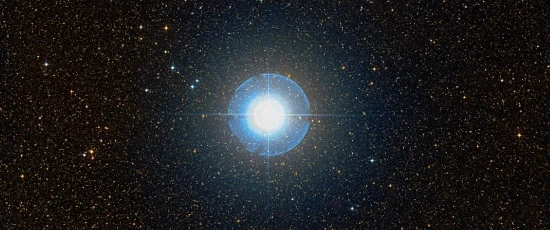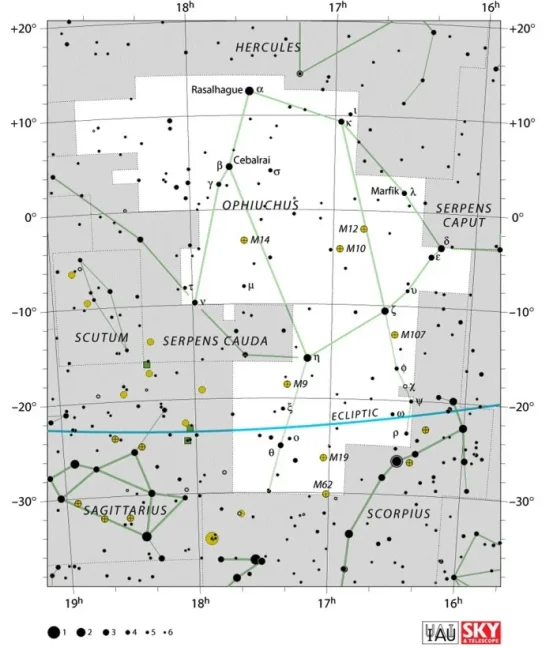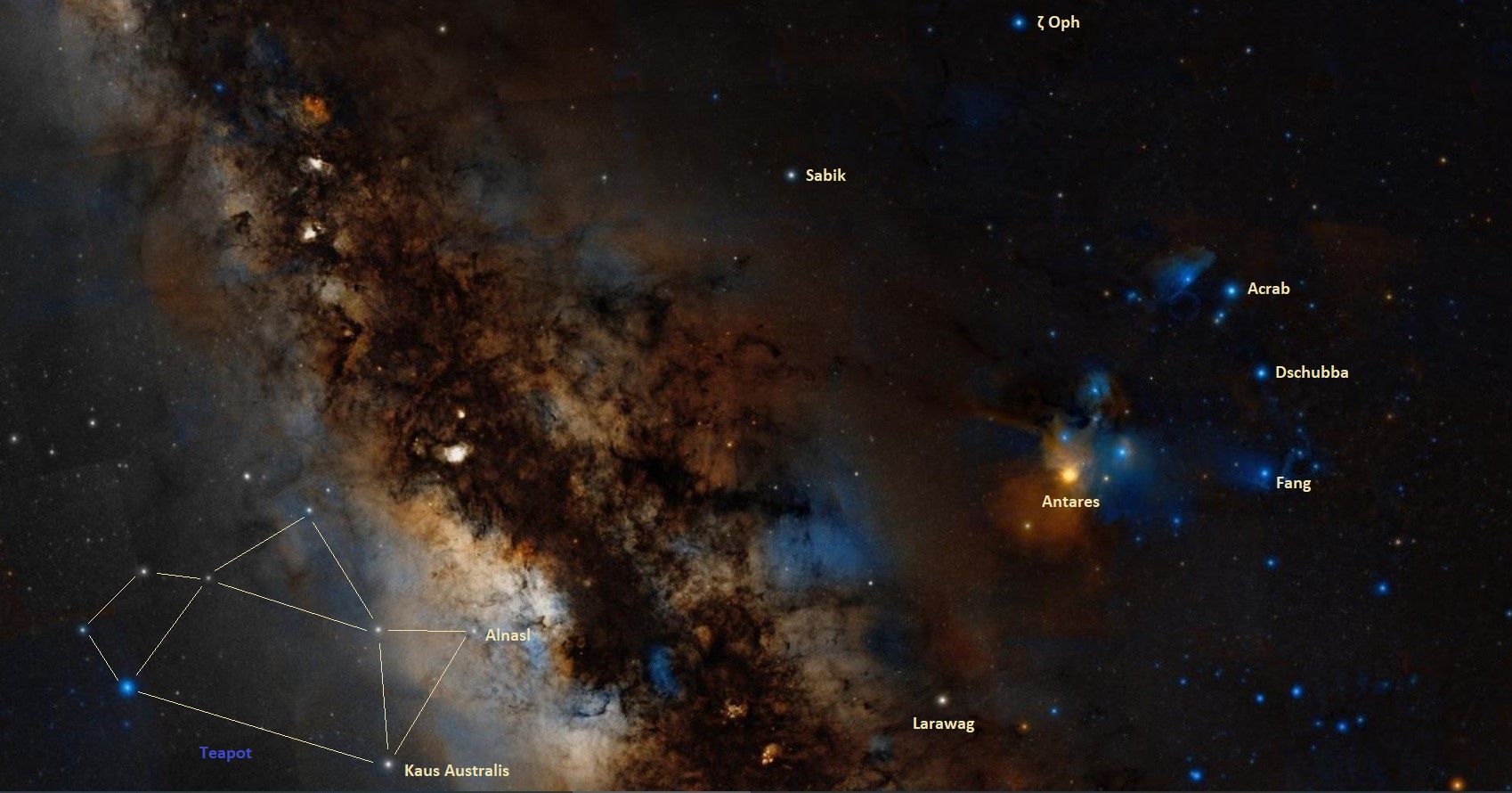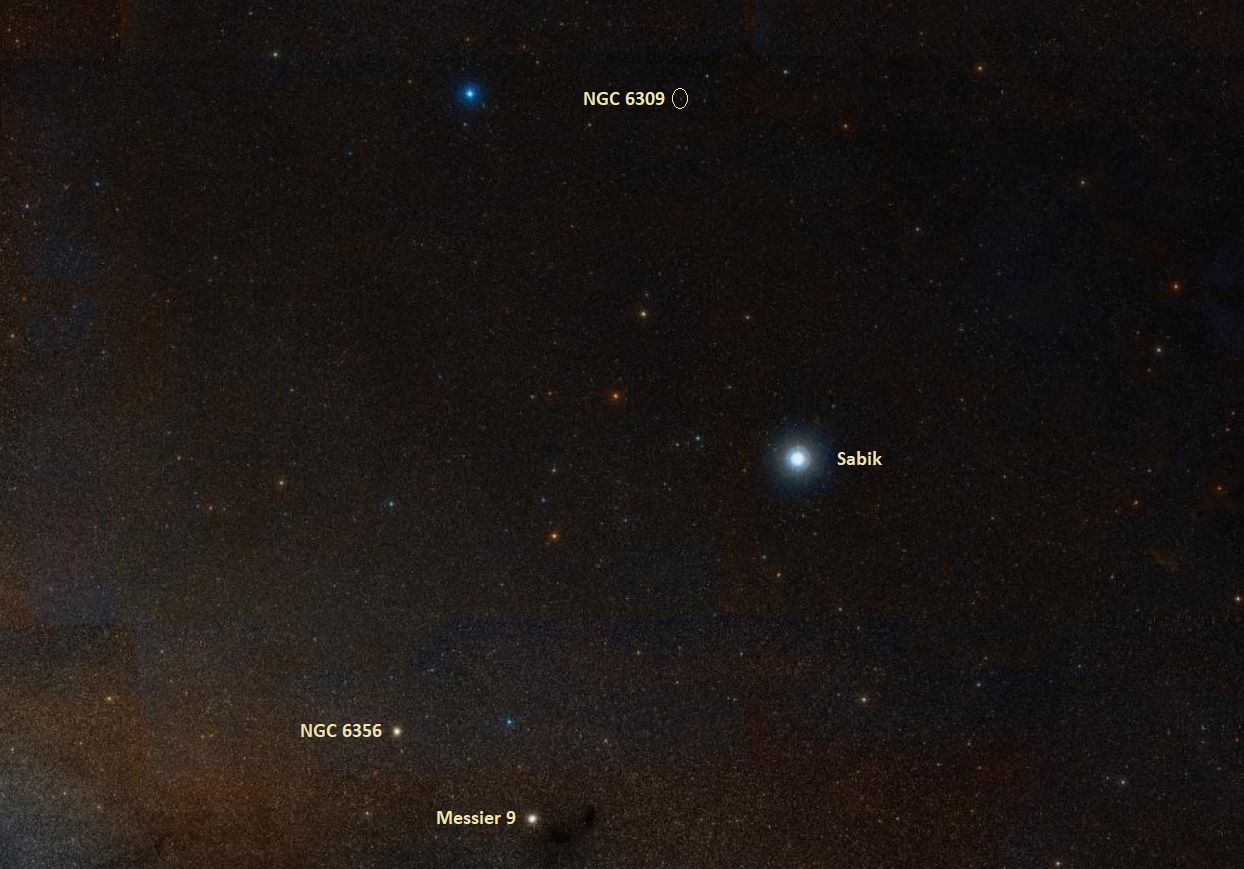Sabik, Eta Ophiuchi (η Oph), is a binary star system composed of two white subgiant stars located in the constellation Ophiuchus. With a combined apparent magnitude of 2.43, it is the second brightest point of light in the constellation, after Rasalhague. Sabik lies at an approximate distance of 88 light years from Earth. It marks the right knee of Ophiuchus, the celestial serpent bearer.
Star system
Eta Ophiuchi is a binary star in a multiple system designated WDS J17104-1544 in the Washington Double Star Catalog. Its two components, Eta Ophiuchi A (formally named Sabik) and Eta Ophiuchi B, have the designations WDS J17104-1544A and WDS J17104-1544B and the binary itself is catalogued as WDS J17104-1544AB. The components C and D in the star system are catalogued as UCAC4 372-080717 and UCAC2 26022336.
Eta Ophiuchi consists of two white stars of the spectral type A1 IV with a total mass of about 6.09 solar masses. Eta Ophiuchi A has 2.966 solar masses, while Eta Ophiuchi B has 3.478 solar masses. Individually, the stars have apparent magnitudes of 3.05 and 3.27. They orbit each other with a period of 87.58 years and an eccentricity of 0.950. The highly eccentric orbit makes it very unlikely for any planets to form in the system. The stars come within 2 astronomical units of each other (two Earth-Sun distances) and drift as far apart as 65 astronomical units. The angular size of their orbit is only 1.396 arcseconds, which translates into an average physical distance of about 33.5 astronomical units.

Sabik (Eta Ophiuchi), image: Wikisky
Facts
Sabik and the brighter Rasalhague are among the 58 stars that have a special status in the field of celestial navigation. The two stars are part of a group of 13 equatorial navigational stars of the western hemisphere. Other navigational stars in this group are Gienah in the constellation Corvus, Altair in Aquila, Fomalhaut in Piscis Austrinus, Arcturus in Boötes, Antares in Scorpius, Nunki in Sagittarius, Alphecca in Corona Borealis, Spica in Virgo, Zubenelgenubi in Libra, and Markab and Enif in Pegasus.
On average, Sabik is the 86th brightest star in the sky. It is only slightly fainter than Enif in the constellation Pegasus, Kappa Scorpii (Girtab) in Scorpius, and Ankaa in Phoenix. It is about as bright as Phecda in Ursa Major and Scheat in Pegasus and it just outshines Aludra in Canis Major, Alderamin in Cepheus, Markeb in Vela, and Gienah in Corvus.
Name
The name Sabik (pronunciation: /ˈseɪbɪk/) is derived from the Arabic al-sābiq, meaning “the preceding one.” It is unclear what the name refers to.
The name was approved by the International Astronomical Union’s (IAU) Working Group on Star Names (WGSN) on August 21, 2016. It formally applies only to the component Eta Ophiuchi A.
The Chinese know Sabik as 天市左垣十一 (Tiān Shì Zuǒ Yuán shíyī), the Eleventh Star of Left Wall of Heavenly Market Enclosure. The Chinese Heavenly Market Enclosure mansion represents the emperor’s realm. The asterism called Left Wall of Heavenly Market Enclosure consists of 11 stars – Sarin (Delta Herculis), Maasym (Lambda Herculis), Mu Herculis, Omicron Herculis, 112 Herculis, Okab (Zeta Aquilae), Alya (Theta1 Serpentis), Eta Serpentis, Nu Ophiuchi, Xi Serpentis, and Sabik (Eta Ophiuchi) – and each star represents an old state in China. Sabik represents the state Song.
Location
Sabik lies close to the celestial equator and can be seen from most locations on Earth for at least a part of the year. It is relatively easy to find because it is located in the same area of the sky as two conspicuous southern asterisms, the Teapot, formed by the brightest stars of Sagittarius, and the claws of Scorpius. Sabik is found to the north-northeast of Antares and just west of the imaginary line extended from Kaus Australis (Epsilon Sagittarii), the brightest star in Sagittarius, through the fainter Alnasl (Gamma2 Sagittarii), the star that marks the tip of the Teapot’s spout.
Sabik can be used to find several bright deep sky objects that lie in the same area of the sky. The globular cluster Messier 9 appears about 3 degrees southeast of the star. It has an apparent magnitude of 7.9 and occupies 9.3’ of the sky. It can be observed in a small telescope.
The globular cluster NGC 6356 lies only 80’ northeast of M9. With a visual magnitude of 8.2, it is slightly fainter than its neighbour.
The Box Nebula (NGC 6309), a quadrupolar planetary nebula, appears less than 3 degrees north and a little east of Sabik. It has an apparent magnitude of 11.5.
Constellation
Sabik is located in the constellation Ophiuchus. Representing the healer Asclepius in Greek mythology, Ophiuchus is usually depicted holding a large snake, represented by Serpens constellation, and it divides Serpens into two parts: Serpens Caput (the serpent’s head) and Serpens Cauda (the serpent’s tail). Both Ophiuchus and Serpens are among the 48 Greek constellations, first listed by the Greek astronomer Claudius Ptolemy in his Almagest in the 2nd century CE.

Ophiuchus constellation map by IAU and Sky&Telescope magazine
Ophiuchus is the 11th largest of the 88 constellations, occupying an area of 948 square degrees. It does not contain any first-magnitude stars that would make it particularly prominent, but with five stars brighter than magnitude 3.00, it is fairly noticeable on a clear night. The constellation’s brightest star, Rasalhague, has a visual magnitude of 2.08.
Ophiuchus is rich in interesting stars and bright deep sky objects. It is home to Barnard’s Star, the fourth closest individual star to the Sun (after the three components of the Alpha Centauri system) at 5.958 light years, the nearby red dwarf Wolf 1061, which hosts three confirmed exoplanets, the recurrent nova system RS Ophiuchi, the massive blue star Zeta Ophiuchi, and Rho Ophiuchi, a multiple star system embedded in one of the nearest star-forming nebulae to the Sun. The constellation also contains Kepler’s Supernova (SN 1604), the remnant of a Type Ia supernova observed in 1604.
Notable deep sky objects in Ophiuchus include the bipolar planetary nebula M2-9 (the Twin Jet Nebula or Minkowski’s Butterfly), the planetary Emerald Nebula (NGC 6572), the large dark nebula known as the Dark Horse Nebula, the Cosmic Bat Nebula, the ultraluminous infrared galaxy NGC 6240, and the bright open cluster IC 4665. The constellation is also home to several bright globular clusters listed in the Messier catalogue: Messier 9, Messier 10, Messier 12, Messier 14, Messier 19, Messier 62, and Messier 107.
The best time of year to see the stars and deep sky objects in Ophiuchus is during the month of July, when the constellation rises high in the evening sky. The entire constellation is visible from locations between the latitudes 80° N and -80° S.
The 10 brightest stars in Ophiuchus are Rasalhague (Alpha Oph, mag. 2.07), Sabik (Eta Oph, mag. 2.43), Zeta Ophiuchi (mag. 2.569), Yed Prior (Delta Oph, mag. 2.75), Cebalrai (Beta Oph, mag. 2.75), Kappa Ophiuchi (mag. 3.20), Yed Posterior (Epsilon Ophiuchi, mag. 3.22), Theta Ophiuchi (mag. 3.26), Nu Ophiuchi (mag. 3.332), and 72 Ophiuchi (mag. 3.73).
Sabik – Eta Ophiuchi
| Spectral class | A1 IV + A1 IV |
| U-B colour index | +0.09 |
| B-V colour index | +0.05 |
| Apparent magnitude | 2.43 (3.05/3.27) |
| Distance | 88 ± 2 light years (27.1 ± 0.6 parsecs) |
| Parallax | 36.91 ± 0.80 mas |
| Radial velocity | -2.40 km/s |
| Proper motion | RA: +40.13 mas/yr |
| Dec.: +99.17 mas/yr | |
| Mass (η Oph A, η Oph B) | 2.966 M☉, 3.478 M☉ |
| Metallicity | -0.01 dex |
| Rotational velocity (η Oph A) | 23 km/s |
| Constellation | Ophiuchus |
| Right ascension | 17h 10m 22.68689s |
| Declination | –15° 43′ 29.6639″ |
| Names and designations | Sabik, Eta Ophiuchi, η Oph, 35 Ophiuchi, HD 155125, HR 6378, HIP 84012, Gl 656.1A/B, SAO 160332, BD–15°4467, GC 23158, GCRV 9900, IRAS 17075-1539, 2MASS J17102267-1543298, JP11 2819, PPM 232699, PLX 3895, UBV 14447, BU 1118, WDS J17104-1544AB, ADS 10374 AB |

